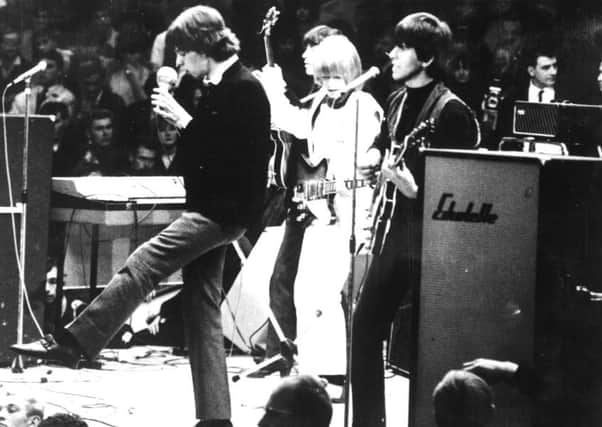Martyn McLaughlin: No satisfaction with Stones myth


THERE would be better years for music, but 1965 was the hinge which turned the 1960s into the Sixties™. The energy unleashed at the dawn of the decade had started to gel into something resolute. In those 12 months, it coalesced into a brand which, for all its fads and psychoses, would come to be adulated and appropriated like no era before or since.
Half a century on, this veneration continues unabated. A slender body of years remains the prevalent influence on our popular culture. Film and fashion have their place, but music is the root of this pandemic, spread by a slew of retrospectives, reissues and remasters that keep the embers of the nostalgia industry’s mushy afterglow smouldering.
Advertisement
Hide AdAdvertisement
Hide AdThe latest artefact continues the trend. A special anniversary numbered 12-inch single, pressed on 180-gram vinyl and cut from the original mono master tapes, it panders to the modern audiophile’s studious fetishisation of the past. Yet the song in question has a rarefied status as the very incarnation of rock music’s mythic power.


(I Can’t Get No) Satisfaction by the Rolling Stones was released half a century ago this Thursday, an interlude brought into stark focus by the original band photograph duplicated on the re-released single’s cover. It resets the 2015 incarnation of Keith Richards - an animatronic version of Miss Marple trussed together by Blu Tac and barbiturates - to his spry adolescence. Above and to his left, Mick Jagger, nowadays a trampled wallet disguised as a face, regains the pouting indignation of a freshly caught carp. Charlie, well, looks like Charlie.
But the shock of the occasion of the song’s half centenary stems most from the recording itself, a jagged vamp rising a minor third from B to D still capable of sending shivers down the spine. Unleashed at a time when Sonny and Cher occupied the chart’s summit, its pugnacious riff cut through the saccharine ubiquity of early rock and roll and the imitative R&B covers the Stones themselves had been diligently churning out. As the author, Andrew Jackson, sagely observed, it was the moment they “graduated from being apprentices of the blues to being on the vanguard themselves”.
It is not the Stones’ best work (an accolade reserved for the fragile, grubby swagger of Exile on Main St), nor is it the best version of the song (a close-run thing between Otis Redding’s brassy Stax stomper and Aretha Franklin’s live version from the Olympia Theatre, Paris, where the backing singers struggle to keep pace with a bewitched Lady Soul). But it acted as a totem of the band’s newfound insouciant force and, more importantly, a bellwether of its times.
Hailed by Newsweek as “the five notes that shook the world,” it was conceived in the year Churchill died and Kenneth Tynan said ‘f***’ on television, when high priests of culture like T.S Eliot gave way to young seminarians such as Michael Frayn. Across the Atlantic, the metamorphosis was even more pronounced; Lyndon Johnson signed the Voting Rights Act into law, Malcolm X was slain, and the first US combat troops arrived in Vietnam.
Satisfaction may be that era’s anointed soundtrack, but its euphoric yelp was an adjunct of change, not the agent of it. If any music acted as a catalyst, it was civil rights anthems such as Dancing in the Street by Martha and the Vandellas or Mississipi Goddam by Nina Simone. Even so, quantifying music’s transformative faculties is a dangerously simple equation when hindsight is among its factors.
Try telling that to successive waves of rock critics intent on earning their place in history’s footnotes by distorting the adrenalin rush of Satisfaction’s three minutes and 43 seconds with layer upon layer of profundity. The track, invoked the New York Times scribe, Robert Palmer, in his 1984 book The Rolling Stones, is “a Trojan horse, a quasi-Marxist critique of consumerism and its cost to society and to the individual,” ignoring the fact the first thing the 21-year-old Richards did with his royalties was to buy a Bentley S3 Continental, which he promptly painted turquoise and customised with a vast Confederate flag.
This week’s remembrances will not prick the obstinate mythology that has sprung up around the song, a lattice of hoary old yarns and excitable revisionism which, like the decade it is said to define, steadfastly refuses to yield though the years fall by. Legends of its genesis will be dusted down and rolled out, detailing how its signature chords might have been lost forever had an addled Richards not committed it to a Philips portable cassette recorder by his bedside; or how Jagger penned its lyrics in ten minutes flat while lounging by a Florida pool.
Advertisement
Hide AdAdvertisement
Hide AdIn the museum of cultural taxidermy which preserves the big beasts of Sixties music in perpetuity, Satisfaction is the centrepiece - there to be gawped at and revered unquestioningly. It is this malaise which mistakes the turgid roots rabble of the Grateful Dead for pioneering mysticism and interprets Jim Morrison’s shabby shamanism as generation-defining genius, all the while overlooking genuinely pivotal acts like Arthur Lee and Love.
The music of the decade is inextricably tangled up in its profitable lore. Appreciating a song like Satisfaction for what it is - a thumping great rock track which tapped into emotions already ubiquitous - no longer suffices. We are forced to embrace and perpetuate its mythic clout. It refuses to be wrenched from its context, oh no no no.
On 23 September 1965, after spending three weeks at number one, Satisfaction gave way to a new chart topper - Make It Easy On Yourself by the Walker Brothers. When, in two days’ time, the usual ragtag of musicologists and second-rate cultural commentators look back through the prism of another anniversary, who among them will remember that sobering fact in their account of the revolution?